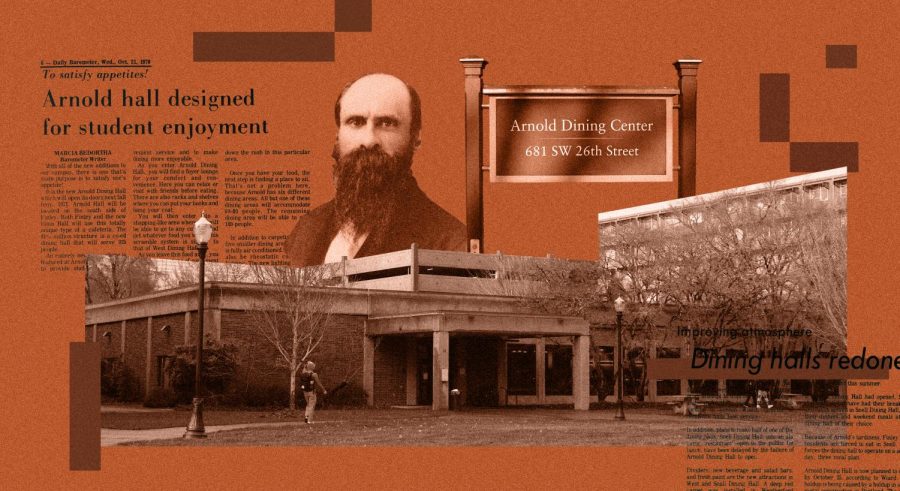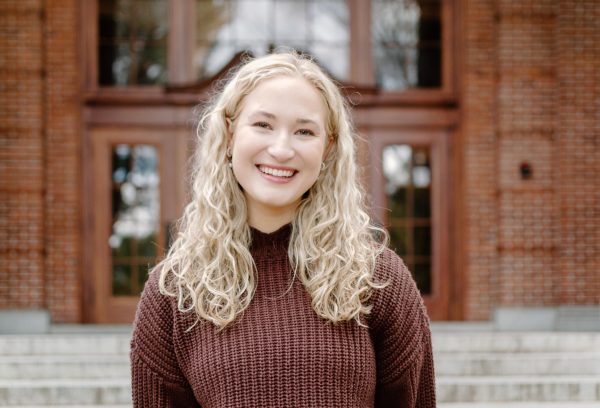‘Arnold Dining Hall’s’ remains unchanged despite being named after racist figure
Alan Nguyen, Ashton Bisner, Jiratana Tungkawachara
Photo illustration depicting Arnold Dining hall, Benjamin Lee Arnold and past Barometer articles on the building.
January 17, 2023
Six years ago, community members raised a question: “What does it mean for Oregon State University to value equity and inclusion if individuals after whom its buildings are named did not?”
The question unearthed so much of OSU’s past and sparked an entire building reconsideration project.
Although the names of some buildings in question were changed, one in particular still remains that shares a similar history to the others: Arnold Dining Hall.
Former OSU president, Edward J. Ray, made the ultimate decision to change the names of three out of the five buildings brought into question:
- Avery Lodge to Champenifu Lodge
- Benton Hall to Community Hall
- Benton Annex to Hattie Redmond Women and Gender Center
- Gill Coliseum was the other building alongside Arnold Dining Hall to see no changes to its name
As Arnold Dining Hall’s name remains unchanged, so too does the history behind the man the hall was named after.
According to the Historical Reports on OSU Building Names: Arnold Dining Hall, Benjamin Lee Arnold was born around the year 1837. During his childhood, his father Jonathan J. Arnold, owned a total of seven slaves between the ages of one and thirty.
“Although he may not have held slaves himself due to his age, he directly experienced and benefitted from the institution of slavery,” the report said.
According to the report, in his college years, Arnold attended Virginia’s Randolph Macon College where he studied slavery. Arnold took classes such as “Political Economy” and “Domestic Slavery” in which he earned proficient grades.
The textbook used in this class, written by William A. Smith, was pro-slavery.
“We do not know that Arnold shared all, or any, of his professor’s opinions, but they must have shaped his thinking on issues of slavery and race,” the report said.
According to the report, Arnold enlisted in the Confederate army after college, starting as a private and most likely promoted to captain later. However, Arnold’s service remains unclear due to incomplete military records.
In 1872, he became the second president of OSU, elected by the Methodist Episocal Church, South, known for its split from the Methodist Episocal Church for its pro-slavery and pro-segregation ideals.
With his history of pro-slavery and pro-segregation ideals, the question can still be raised about whether or not Arnold is worthy of representing an OSU building.
“I’m not shocked,” said Josh McCormick, a second-year student at OSU when he discovered the true history.
According to McCormick, there are many pushes for certain movements that help certain groups, but when it comes to changing the name of a building because of its racist background, it becomes a bigger dilemma.
“If we’re investing time and energy into other progressive movements, we should be investing time and energy into all movements to make everyone feel included,” McCormick said.
“Just the fact that he was in the [Confederate] army, it clearly states which side he was on, personally. So I also think that it justifies he was in fact fighting on the Confederate side during the Civil War,” said Brandon Hamilton, a third-year student at OSU,
According to Hamilton, he believes there are more individuals in OSU’s past that could be honored through renaming the building.
“We should be willing to recognize the honor and dignity of those who spent their lives simply in pursuit of bettering the world around them: the teacher, who lived their whole life enriching students’ lives, is just as worthy of honor and respect as the influential principal, mayor, or even president,” said Ryan Dukelow, a third-year student at OSU.
When asked, each interviewee said Arnold Dining Hall’s name should be changed.
“I definitely think (the name) should be changed. Now, I think a lot of people aren’t aware of the fact that our dining hall was named after something like that. I feel like if more students or people in general just knew about that, the more petitions there would be to change it,” Hamilton said.
Dukelow often calls the dining hall the “Southside dining hall” because the name infers its location for individuals unfamiliar with campus.
According to Dukelow, Arnold Dining Hall was built by many hard workers who were not remembered by the building’s name, and the workers who currently serve in the building and students who eat there every day did not have a say in the naming.
“This just goes to show that in the state, or just this country, that there’s a lot of racist or non-inclusive endeavors that go on that we aren’t necessarily aware about. And the only way to become aware of that is just to be further educated on the matter,” Hamilton said. “This is another example of how this country is somewhat built upon racism.”
In the end, after discovering the history behind the name, OSU students say Arnold Dining Hall should no longer represent the pro-slavery and pro-segregationalist ideals it stands for today.

























































































































